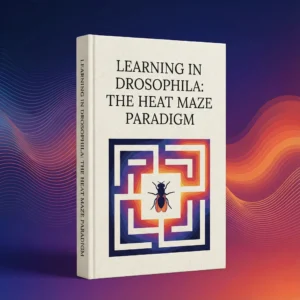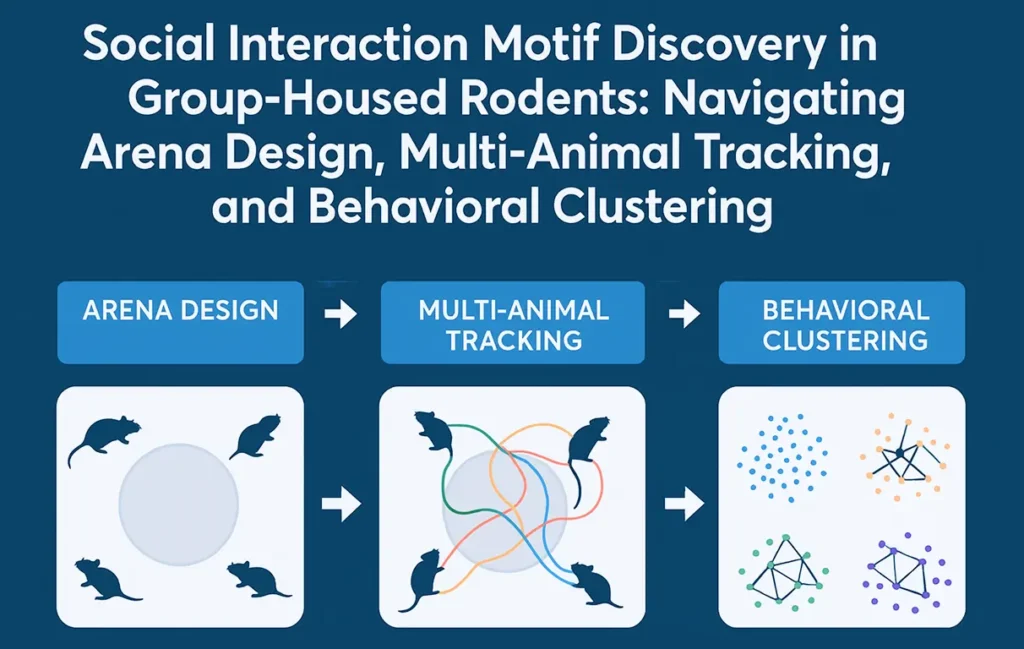

Understanding the social lives of rodents is critical for advancing neuroscience, behavioral science, and preclinical research. In natural conditions, rodents live in groups and engage in complex, dynamic social interactions—ranging from subtle affiliative gestures to overt displays of aggression or dominance. Capturing these interactions systematically has long posed a challenge for researchers, particularly when animals are freely moving, unmarked, and housed in shared arenas.
In recent years, the convergence of pose estimation, identity tracking, and unsupervised behavior modeling has opened up new frontiers for studying social dynamics at unprecedented resolution. This article explores the scientific and technical landscape of social interaction motif discovery in group-housed rodents—focusing on how to design experimental arenas, resolve identity ambiguities, and extract motifs like chasing, huddling, and dominance behaviors.
Social interactions are deeply intertwined with neural function. They engage circuits involved in reward, fear, motivation, and executive control. Disruptions in social behavior are central to various psychiatric and neurodevelopmental conditions, including autism spectrum disorders, schizophrenia, depression, and PTSD. Rodent models have been instrumental in exploring these domains, but traditional assays often reduce social behavior to simple metrics—like time spent near a conspecific or number of approaches—overlooking the rich temporal structure and dyadic/triadic complexity of real social interactions.
To advance social neuroscience, researchers must move beyond simple preference tests and toward continuous, high-resolution analysis of group interactions in ecologically valid settings.
The foundation of any high-quality social interaction study lies in arena design. Conduct Science offers modular and scalable solutions for both short-term social assays and long-term group housing studies. Key considerations in arena design include
Arena material should also minimize reflection and facilitate contrast-based pose estimation. High-friction flooring can prevent slippage during high-velocity events like chasing or fighting.
For extended observations, home-cage social arenas integrated with food/water systems and bedding help preserve circadian rhythms and reduce stress while still supporting high-throughput tracking.
Studying group-housed rodents presents a fundamental technical hurdle: accurately tracking multiple, visually similar animals without physical markers, especially during close, dynamic interactions. As rodents navigate shared environments, they often engage in social behaviors—like huddling, chasing, grooming, or mounting—that involve intense proximity, partial occlusion, and rapid movements. These interactions can confound even advanced tracking systems, leading to identity swaps, loss of track continuity, or incorrect posture reconstructions.
Unlike single-animal studies, where pose estimation algorithms can consistently identify anatomical landmarks with minimal confusion, multi-animal scenarios demand a more sophisticated approach. Each animal must be tracked individually and continuously across frames—even as they intersect, overlap, or engage in reciprocal behaviors. Maintaining accurate identity over time is crucial, as any error cascades into downstream analyses of interaction dynamics, motif clustering, and neural-behavioral alignment.
Addressing this challenge involves integrating several complementary solutions:
Conduct Science’s modular arena platforms are compatible with such tracking pipelines, offering stable, camera-friendly environments that reduce visual noise, support infrared backlighting, and enable flexible camera configurations for multi-view capture.
Without reliable identity tracking, behavioral motifs involving social interaction cannot be properly assigned. Consider a chase sequence: mislabeling the chaser and the chased not only reverses the behavioral context but also corrupts any link between neural activity and action attribution. Similarly, motifs like grooming another animal, assertive mounting, or flight responses are all contingent on knowing who did what to whom.
Accurate identity tracking allows researchers to
This precision is especially critical when linking behavior to brain data, such as in experiments using wireless electrophysiology or optogenetics, where interpreting neural signals depends on knowing exactly what behavior the implanted animal was performing—and with whom.
In group-housed rodent studies, behavior does not occur in isolation—it unfolds continuously, shaped by social context, internal states, and the actions of others. To understand these dynamics at a meaningful scale, researchers must move beyond isolated movement descriptors and into the realm of behavioral motifs: short, recurring patterns of interaction that reflect distinct social functions. The process of discovering and categorizing these motifs from raw movement data is at the heart of modern ethological analysis, and it relies heavily on unsupervised machine learning techniques.
The first step in motif discovery is transforming pose estimation data into socially relevant features. When multiple animals are tracked simultaneously, researchers can compute rich, dynamic descriptors of their interactions, such as:
By combining these features across time, researchers generate a high-dimensional behavioral space where every moment of interaction is represented as a point with complex structure.
To identify patterns within this vast space, dimensionality reduction techniques such as UMAP (Uniform Manifold Approximation and Projection) or t-SNE (t-distributed Stochastic Neighbor Embedding) are employed. These algorithms project high-dimensional features into a lower-dimensional latent space, preserving the local and global structure of the data.
In this compressed space, similar interactions cluster together—whether they’re grooming bouts, nose-to-flank investigations, pursuit-flee episodes, or mounting attempts. These clusters represent candidate behavioral motifs, revealed not through subjective labels but through statistical consistency.
Once embedded, clustering algorithms such as k-means, Gaussian Mixture Models, or HDBSCAN group points into discrete motif categories. Each cluster captures a unique interaction type, defined by its movement dynamics and social structure (e.g., one-to-one contact, group aggregation, asymmetric postures).
Beyond static clustering, researchers can apply temporal models such as Hidden Markov Models (HMMs) or sequence transition graphs to uncover the flow of social behavior. These models reveal
These transitions form the grammar of social interaction—offering insights into the rules and flexibility of social exchange in rodents.
Each motif discovered through clustering can be interpreted as a social behavior unit. For example:
These motifs can be assigned ethological meaning, allowing researchers to link them to underlying motivational states, social roles (e.g., dominant vs. subordinate), or experimental conditions (e.g., stress, pharmacological intervention).
Once motifs are defined, they become powerful analytical tools:
This approach offers far greater resolution than conventional scoring methods, which often reduce complex behaviors to aggregate metrics like “time spent in contact” or “number of approaches.”
Social behavior in rodents is composed of structured, often stereotyped patterns that recur within and across individuals. These key social motifs—brief but meaningful interaction units—serve as the building blocks of social dynamics. By analyzing large-scale pose and trajectory data through unsupervised clustering methods, researchers can isolate these motifs and assign them ethological significance. In group-housed settings, where multiple rodents interact freely, a variety of dyadic and triadic behaviors emerge naturally and can be mapped with high temporal and spatial precision.
Below are several core social motifs commonly observed in rodents under naturalistic housing conditions:
This motif is characterized by one animal rapidly pursuing another, often with clear directional alignment, decreasing inter-animal distance, and elevated speed. The “chaser” displays forward orientation and a persistent velocity vector aimed at the conspecific, while the “fleeing” animal may exhibit abrupt directional shifts or escape accelerations.
Scientific relevance: Often associated with dominance interactions, social hierarchy formation, and aggression models. Variations in this motif can indicate altered threat perception or hyperactivity.
Huddling occurs when two or more animals assume a stationary, side-by-side, or stacked configuration, often during rest or thermoregulation. This motif shows minimal locomotion, synchronized postures, and extremely low inter-animal distances. Pose aside, action reveals overlapping or parallel body orientations and mutual contact.
Scientific relevance: A core affiliative behavior linked to social bonding, stress regulation, and comfort-seeking. Reductions in huddle motifs are often observed in models of social withdrawal or depression.
Dominance displays include mounting, pinning, or vertical posturing over another animal. This motif exhibits asymmetrical spatial positioning, elevated body height for the dominant animal, and stationary or submissive postures in the subordinate.
Scientific relevance: Critical for assessing social hierarchy, assertiveness, and aggression. Motif frequency and transitions are often used to evaluate dominance dynamics or the effects of pharmacological interventions targeting aggression or social rank.
This motif is identified by one animal slowly approaching another with low velocity and focused head orientation—typically toward the anogenital or flank region. Investigation behaviors are brief, yet structured, and often precede affiliative or competitive interactions.
Scientific relevance: A key measure of sociability and social interest. Disruptions in the frequency or completion of this motif are hallmark indicators in models of autism spectrum disorder or social anxiety.
Though self-grooming is often solitary, in social settings rodents may engage in allogrooming, where one animal grooms another’s head, back, or flanks. These motifs involve rhythmic, repeated movements of the forepaws or snout, close contact, and stationary postures.
Scientific relevance: Reflects affiliative behavior and social cohesion. Increased grooming may also appear as a coping response in stress paradigms, while decreased grooming suggests social disengagement or anhedonia.
In this motif, an animal abruptly changes direction or flees after an approach or encounter, typically accompanied by high-speed escape, tail elevation, or partial freezing.
Scientific relevance: Reflects anxiety-like behavior or low dominance status. Often exaggerated in stress models or in animals exposed to early-life adversity or trauma.
One animal consistently maintains a position directly behind or beside another, mirroring its movements over extended periods. This includes trailing at close distance, with aligned orientation and matched velocity.
Scientific relevance: Linked to affiliative pair bonding, social exploration, and juvenile play behavior. Disruptions may indicate impaired social imitation or tracking deficits.
Each of these motifs is more than a simple label—they are quantifiable units of interaction that can be
Motif-based analysis also allows for temporal sequencing—understanding how social behaviors unfold across time. For example, a social investigation may escalate to mounting or de-escalate to huddling, depending on context and the individuals involved. Transition probabilities between motifs offer insight into social flexibility, responsiveness, and control.
The ability to extract and analyze social behavior motifs in group-housed rodents is transforming how researchers study neurological and psychiatric disorders, as well as how they assess the impact of therapeutic interventions. Traditional behavioral assays—like the three-chamber social test or single-trial aggression paradigms—often fail to capture the temporal richness, context sensitivity, and spontaneous complexity of real-life social interactions. In contrast, motif-based analysis enables researchers to monitor and quantify how rodents initiate, sustain, and transition through social behaviors under naturalistic conditions, offering a powerful framework for preclinical modeling.
Social interaction deficits are core features of many brain disorders, and behavioral motifs provide a granular lens through which to view these impairments.
These detailed behavioral fingerprints allow researchers to map behavioral pathologies onto specific social functions, offering more precise behavioral phenotyping than conventional metrics.
Motif-based behavioral profiling is ideally suited for testing and comparing therapeutic compounds. It provides high-throughput, high-resolution data on how drugs alter social interaction, with several advantages:
The fine-grained, interaction-specific data provided by motif analysis supports cross-species comparisons with human social behaviors. Many motifs—such as approach/avoidance dynamics, synchronized movement, or gaze-following equivalents—have analogs in human social interaction. This makes motif data more relevant to clinical symptom domains, enhancing the translational value of rodent models for disorders like ASD, schizophrenia, and social phobia.
Moreover, the combination of behavioral motifs with neural recordings (e.g., LFPs, optogenetics, calcium imaging) allows researchers to probe:
The trajectory of neuroscience is increasingly embracing an ecologically valid, naturalistic approach—recognizing the brain as an organ evolved to navigate complex, dynamic, and social environments. This paradigm shift is transforming social neuroscience, moving away from studying isolated interactions under constrained paradigms toward understanding how animals behave and interact freely, continuously, and adaptively. Group-housed rodents serve as an exemplary model for this transition, offering rich behavioral repertoires, complex social hierarchies, and parallels to human social dynamics.
Traditional assays often quantify social behavior using single-point metrics, such as total time spent near another animal or the number of contacts initiated. While informative, these measures fail to capture the temporal structure, sequence, and context that define real social behavior. Naturalistic social neuroscience focuses on behavioral flow, interaction dynamics, and contextual modulation, necessitating tools that can capture, quantify, and analyze behavior at scale across space and time without human-imposed categories.
The integration of neural recordings with social interactions enhances the power of naturalistic approaches. Aligning local field potentials (LFPs), spike trains, or calcium signals with data-rich behavioral motifs allows researchers to explore neural dynamics differentiating mutual investigation from dominance assertion, oscillatory patterns during affiliative versus aggressive transitions, and neural circuits predicting and responding to changing social hierarchies. This approach facilitates real-time closed-loop experiments, where brain activity during specific motifs is manipulated on the fly, shedding light on causal mechanisms of social behavior.
Naturalistic social neuroscience also emphasizes individual-level analysis. In group settings, each rodent exhibits unique behavioral styles, mirroring the variability seen in human populations. Motif-based analysis enables tracking individual repertoires across days and contexts, identifying stable traits, and modeling how internal states shape social decisions. This paves the way for precision behavioral neuroscience, where treatments are evaluated not just by group averages but by shifts in individual behavioral patterns in real time.
The future of naturalistic social neuroscience lies at the intersection of several converging forces: high-speed, high-resolution video tracking of multiple animals in complex environments; unsupervised machine learning to discover and organize behavioral motifs without human bias; advanced neural recording and manipulation tools, including optogenetics and wireless electrophysiology; and ethologically informed arena design enabling natural behaviors to emerge freely. Conduct Science’s modular platforms exemplify this convergence by offering customizable arenas, synchronized multi-camera systems, and compatibility with neural interface tools, essential for implementing cutting-edge social neuroscience protocols.
Ultimately, naturalistic social neuroscience supports a deeper and more honest theory of brain function—one grounded not in artificial tasks, but in the core ecological challenges animals face: Who am I interacting with? What are they likely to do? How should I respond? These are the questions the brain evolved to answer, and they cannot be fully understood without embracing the complexity, fluidity, and richness of real social life. By adopting tools that let animals express their full behavioral range and analyzing their behavior in its natural structure, neuroscience becomes more accurate, humane, translational, and relevant to understanding ourselves.
For an in-depth look at modular arena configurations and tracking demonstrations, visit the Conduct Science YouTube Channel or explore ConductScience.com, where customizable tools support every step from experimental design to behavioral quantification.
Berman, G. J. (2018). Measuring behavior across scales. BMC Biology, 16(1), 23. https://doi.org/10.1186/s12915-018-0494-7
Pereira, T. D., Shaevitz, J. W., & Murthy, M. (2020). Quantifying behavior to understand the brain. Nature Neuroscience, 23(12), 1537–1549. https://doi.org/10.1038/s41593-020-00734-x
Wiltschko, A. B., et al. (2015). Mapping sub-second structure in mouse behavior. Neuron, 88(6), 1121–1135. https://doi.org/10.1016/j.neuron.2015.11.031
Datta, S. R., et al. (2020). The science of behavior: integrating movement and brain activity in freely behaving animals. Nature Neuroscience, 23(12), 1522–1531. https://doi.org/10.1038/s41593-020-00703-4
Mathis, A., & Mathis, M. W. (2020). Deep learning tools for the measurement of animal behavior in neuroscience. Current Opinion in Neurobiology, 60, 1–11. https://doi.org/10.1016/j.conb.2019.10.008
Conduct Science. (n.d.). Behavioral Neuroscience Solutions—Open Field, Modular Arenas, Home Cage Systems, Tracking Tools. Retrieved from https://conductscience.com/
Conduct Science. (n.d.). Social behavior research and customizable systems. YouTube. Retrieved from https://www.youtube.com/@conductscience
